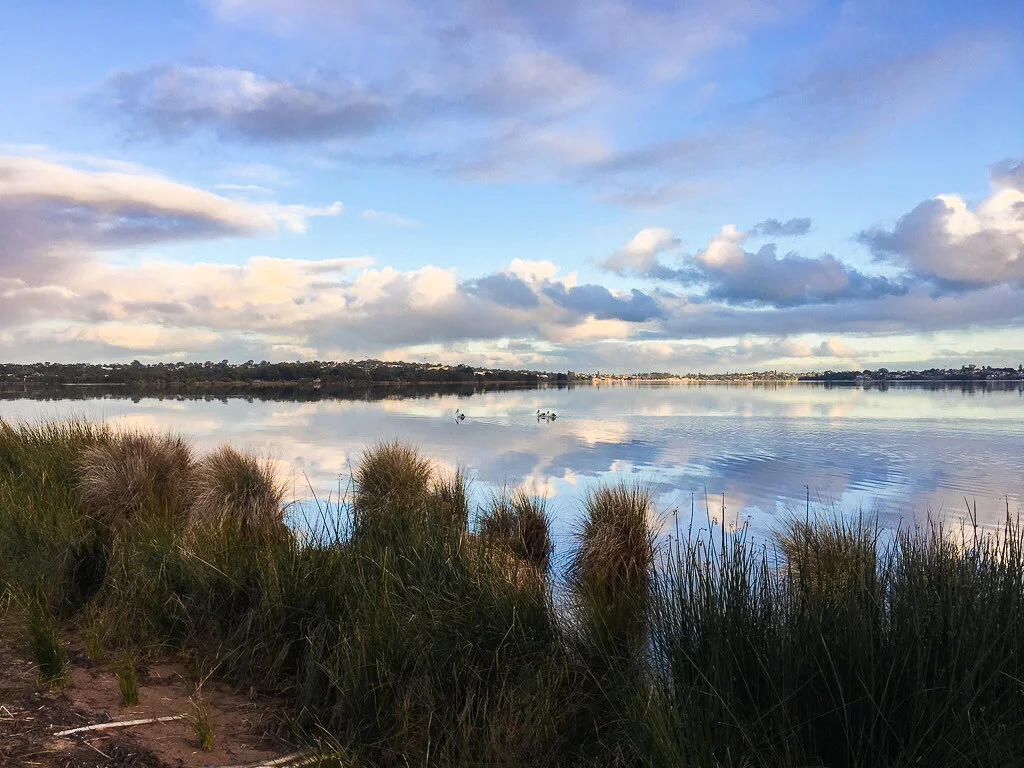
Derbarl Yerrigan The Swan Estuary
Milyu in South Perth, Alfred Cove in Melville and Pelican Point in Crawley provide important habitat for many species of local and migratory birds, including trans-equatorial wading birds from as far away as Siberia. Waders and water birds move between the three reserves on a daily basis – their sandbanks, mud-flats and beaches providing the only significant feeding, nesting and resting areas remaining in the Swan River Estuary.
Map via parks.dpaw.wa.gov.au
Location
Forming the backdrop to the city of Perth, the Swan River Estuary extends approximately 60km from Fremantle to Ellen Brook, and 6km up the Canning River to Kent Street Weir. Its waters pass through the Swan Coastal Plain, the Guilford Formation and the Bassendean, Spearwood and Quindalup Dunes, each major landform unit having its own specific vegetation communities populating the Estuary’s banks.
Shallow sills of soil and mud divide the Estuary into three main sections: the Upper, Middle and Lower Estuaries. Essentially, the Upper Estuary is up-stream from Heirisson Island, the Middle Estuary encompasses Melville Water and the Lower Estuary is downstream from Point Walter.

The Reserves
The Swan River Estuary provides grace and beauty to the city of Perth and its surrounding suburbs. It is central to our way of life.
The original vegetation that once fringed its waters was unique and diverse, and included Samphire flats, sedgelands (juncus kraussii), forests of paperbark (Melaleuca rhaphiophylla) and flooded gum (Eucalyptus rudis), and stands of river sheoak (Casuarina obesa). It provided habitat for many species of waterbirds and land birds, including migratory wading birds. The fringing vegetation also protected the Estuary margins, reducing erosion and filtering nutrients and pollutants flowing into the river.
There is now very little surviving of this natural environment.
The removal of the rocky bar across the entrance of the river in order to construct the Port of Fremantle has increased marine influence. The dredging of channels has changed circulation patterns and altered chemical and biological processes. Fringing vegetation has been cleared for housing, industrial development, transport and recreation. The inappropriate dumping of rubbish and use of fertilisers in farming areas within the catchment and on urban gardens have left the Swan River Estuary in a highly stressed condition, with toxic pollutants and a proliferation of algal blooms. A decreasing rainfall pattern and the effects of climate change are impacting and will continue to impact on the future health of the Estuary and the fauna it supports, causing significant community concern.
This concern, and a better understanding of the importance of fringing vegetation to the health of the Estuary, has been translated into state and local government agencies and community groups undertaking restoration projects to redress negative human impacts and to restore natural aesthetic values.
In 1990 the community set aside three relatively small but very important areas of vegetation and adjacent river shallows as the Swan Estuary Marine Park, which includes the A-Class Reserves of Alfred Cove (8.7ha), Pelican Point (5.5ha) and Milyu (4.4ha). They have been established "to maintain and restore the natural environment, and to protect, care for and promote the study of indigenous flora and fauna and to preserve any features of archaeological, historic or scientific interest". Together they provide sanctuary to native fauna – particularly bird-life – which use each reserve on a daily basis for foraging, breeding and roosting, depending on weather and tidal conditions.
It is the aim of the SERAG to promote the ecological health and well-being of these Reserves and the native flora and fauna they support.
Read about the flora and fauna of the estuary here.

Community Concern
European settlement has had an irrevocable impact on the Swan River Estuary and its surrounding landscape and the banks of the Swan and Canning Rivers are still being cleared of native vegetation. When coupled with the emerging impacts of climate change and a rapidly increasing population, the result is an Estuary in crisis, with impacts not only affecting the human population, but also native flora and fauna, with fish species and birdlife diminishing rapidly.
Community concern over the health of the Estuary has been steadily growing for decades and has seen the proclamation of the Swan River Conservation Act in 1958, as well as the establishment of the Swan River Conservation Board, which later became the Swan River Trust. In the Middle Estuary, three small A-Class Reserves (Milyu, Pelican Point and Alfred Cove) have been set aside as sanctuaries for birdlife, while the Swan Estuary Marine Park was established in 1999.
The 'Community Survey of Future Values and Aspirations for the Swan and Canning Rivers' prepared in 2007 by Research Solutions for the Swan River Trust found:
The rivers' natural areas and overall health take priority in terms of overarching attitudes towards the rivers, with more than 9 in 10 respondents agreeing or strongly agreeing that: the natural areas along the river are really important and should be retained (95.6%).....It is acceptable that certain parts of the river foreshore to be closed off for the protection and rehabilitation of the natural environment (92.5%)..... (Page 2)
...respondents displayed a strong preference for improved flora and fauna outcomes..... A strong preference for a significant portion of the rivers to be dedicated to natural environments. One of the most preferred visual landscapes is a natural one, with reeds, sedges and marshland.... (Page 7)
As pressures mount on natural areas from urban expansion and climate change - and with greater understanding of the importance of natural areas to human mental and physical well-being - hopefully these attitudes towards protecting our natural heritage will have strengthened.
How you can make a difference!
We’d love you to participate in our activities or enjoy our events, and even something as simple as becoming a member is in itself a significant contribution.





